Contemplating on Julian of Norwich (original) (raw)
JULIAN OF NORWICH, HER SHOWING OF LOVE AND ITS CONTEXTS �1997-2024 JULIA BOLTON HOLLOWAY || JULIAN OF NORWICH || SHOWING OF LOVE || HER TEXTS || HER SELF || ABOUT HER TEXTS || BEFORE JULIAN || HER CONTEMPORARIES || AFTER JULIAN || JULIAN IN OUR TIME || ST BIRGITTA OF SWEDEN || BIBLE AND WOMEN || EQUALLY IN GOD'S IMAGE || MIRROR OF SAINTS || BENEDICTINISM || THE CLOISTER || ITS SCRIPTORIUM || AMHERST MANUSCRIPT || PRAYER || CATALOGUE AND PORTFOLIO (HANDCRAFTS, BOOKS ) ||BOOK REVIEWS || BIBLIOGRAPHY || Simone Martini, Museo Horne, Florence � Editrice Giusti de Becocci, SRL, Italy.
PREFACE: CONTEMPLATING ON JULIAN

imone Martini painted this diptych, like two leaves of a book, in Julian's century. Its two icons, to be used for prayer, are Julian's own, her vision of Mary, the Mother of her just-born Creator, 'contemplating all these things in her heart' (Luke 2.19), and of the Piet�, Birth and Death, our Life's bookends, joining together, becoming one, with the diptych's closure. The Piet�'s hands, with our names engraved upon their palms, reach out beyond the frame to us, echoing those of the Mother caring for her Child, our Brother. All this Julian gives also in her text, The Showing of Love.
imilarly we use throughout this Website Julian's two opposing colours, the blue of eternity, of Mary's robe (though here it is the Byzantine blue-black and red) and of the robe Julian gives the Lord in her Parable, with the red of blood, of life, of death. These are the colours as well of Aaron's High Priestly robe, his cloak for prayer, which was blue like the sky, embroidered with scarlet pomegranates, perhaps by his wife, Elizabeth, perhaps by his sister, Miriam. Christ is the one High Priest, garbed in his mother's blue cloak, and her white veil, and wounded with our humanity, with our red blood and mocked with our purple pomp. Later medieval manuscripts, including those of Julian of Norwich's Showing Of Love, make such use of the two colours of Aaron's robe, red and blue , for their capitals, alternating the colours, as a book of memory for their readers. Though before the Norman Conquest manuscripts instead used redsand greens, which we replicate for our entries on Anglo-Saxon literature. * = our web essays, � = external links needing internet connection, other hyperlinked words are available internally on this CD. Put on these texts as you would put on your robes of sky blue for prayer, your 'Bells and Pomegranates ', 'oneing' yourself to eternity.
e have created first booklets, then the website, then a CD, for the use of the general reader, for the contemplative reader, and for the scholarly reader. Vincent Gillespie and Maggie Ross have collaborated on a fine essay on the reading of Julian of Norwich's Showing of Love in lectio divina ("'With mekenesse aske perserverantly": On Reading Julian of Norwich', Mystics Quarterly 30 [September/December 2004], 122-137). Such reading has a structure that is much like the human brain, its hyperlinks, synapses. This website and CD are, hopefully, your 'cell of self-knowledge', the pilgrimage within, through the reading and sharing in others' contemplation, finding in these texts across time, these silent voices, a oneness. We have graded the texts as to whether they are for the general reader, for the contemplative, or for the scholar - or for some, or for all, of these. Our scholarly desire has been to study primary, rather than only secondary materials, concerning Julian, plunging into manuscript and archival research, studying the archeology of buildings associated with Julian, finding those who influenced her, like St Birgitta of Sweden andNicholas of Lyra, and then sharing these sources with you. All the while we have attempted to live Julian's life of prayer, of contemplation, in the 'apostolate of the scribe', as Guigo II called his Carthusian solitaries, our apostolate being to the World Wide Web. For writers need the concentration of the 'room of one's own', the absenting of external stimuli, to find there the Word. When the Orthodox monk Father Nathanael created this icon of Julian he chose the face of Mary from the Fra Angelico Cook Tondo in the National Gallery, Washington.
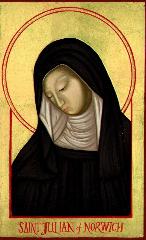
Here we gaze on Julian gazing on Mary, contemplating within her in the Advent Great 'O's, in these golden pages, the Child within her who is not yet born, the Word who is within the anchorhold of her womb.
____ ___ ___
___ ___
THE JULIAN LIBRARY PORTFOLIO
henDante wrote the Vita Nuova here in Florence he gathered up together, like a bunch of wild flowers, scarlet poppies and blue cornflowers, from the hills of Fiesole, a florilegium of his past poems and then explained them. This gathering of material is both for academic scholars researching Julian and for those who turn to Julian for spiritual guidance.

May Flowers, Fiesole, Italy
It began as a portfolio of essays, which were given to England's British Library and her Bodleian Library, then these gravitated to the Web. The structuring of Julian's Web , like Dante's Web, and indeed, the creating of a website, with its hypertext links, is as complex as are shapes in Nature, where God plays games with flowers, having them mirror suns and stars, and where intertwines of dewy cobwebs and of thistledown weave intricacies. Julian is not linear, constructing her text withsquare lintels and posts, but she and her editor consciously analogize her to God's Daughter, Wisdom, sweetly ordering all things, creating a Gothic structure with tensions and tracery, like the webbing and vaulting we see still in Norwich's Cathedral and Cloister, like a web seen in the dew, sparkling with rainbow facets, that I saw, walking to Mass in the dawn, chanting St Patrick's Lorica on the way.

Norwich Cathedral
Julian's Long Text constantly, consciously, cross-references back upon itself. So can the texts of the umilta website form synapses upon themselves. Our own bodies, our own minds, similarly are formed of genetic codes, our elements may be charted. We can 'one' with books, we can 'one' with Creation. Julian does so with a hazelnut in the palm of her hand,with scales of a herring, with raindrops from thatched eaves. Julian seems acquainted with Hebrew, where each letter is also a thing and a number, the smallest letter of all, yod, which begins God's name and Julian's, meaning also 'hand' and 'ten'. All are Fibonacci curves, are exquistie fractals. All is a sacred alphabet .

Hand with Hazlenut, Olive Leaves
The edition and its facing page translation and several other books, Anchoress and Cardinal: Julian of Norwich and Cardinal Adam Easton, Julian among the Books; Julian of Norwich's Theological Library, Mary's Dowry; An Anthology of Pilgrim and Contemplative Writings/ La Dote di Maria: Antologie di Testi di Pellegrine e Contemplativi , are based on a study of all the known manuscripts containing Julian's text, including the Westminster Cathedral Manuscript.* The edition and translation particularly makes use of the two Leeds University Theses written by Sister Anna Maria Reynolds, C.P ., in 1947, 1956. The companion web essays similarly survey women and theology through time.
*
These booklets in the Julian Library Portfolio*, now become web essays, serve several purposes. Augustine was converted through reading a book left lying in a garden in Milan. A Yorkshire contemplative composed a most beautiful illuminated manuscript about past contemplatives, like St Jerome*, Richard Rolle*, and St Hilda*, and asked that his book be left lying about so that it might convert other readers, too, to the contemplative life. Upon his pages he paints the images of these contemplatives, stressing for Richard Rolle his garb embroidered with Jesus' name upon its breast. The booklets, likewise, were modeled on Benedictine* English exiled nuns' contemplative writings, and are sewn together in fascicles like theirs, which could have engravings pasted in of a Benedictine monk at prayer before a Crucifix, and which were to be found in a nun's cell at her death and be treasured and re-copied by the other Sisters in their devotions. Quaker women and men similarly had a tradition of writing Journals (like Augustine's_Confessions_*, Dante's Vita Nuova*, Julian's Showing of Love*), centred on their contemplations, to be read when they died.These booklets were gathered into hand-made portfolios, bound with hand-printed Florentine papers. They are books written in contemplation, about contemplation and for contemplation.
During the entering of the hard copy booklets into HTML code for the umilta webspace and the creating of their links it became clear that women's presence is and always has been woven, as in nature, into the tapestry of Creation, of the Bible , the Gospel , though unnoticed in universities' lecture halls where theology has been taught for centuries in their absence. Without three women, his mother, his sister Miriam, and Pharoah's daughter, Moses would have been killed in infancy, rather than lived to save his people from bondage. Had David loved only Jonathan there could have been no Jesus. Without Mary, and Mary Magdalen, and the other Maries at the Tomb, telling their 'idle tales', the 'Good News' to the Apostles, what Gospel of 'Christ', the Anointed One, could have been announced? Even the forgotten, Ada Lovelace, Lord Byron's daughter, taught by Mary Somerville,, conceived of the computer as done with Jacquard loom cards with holes punched in them and the Binomial Theorem of zeros and ones, so attune with Julian's theology of noughting and oneing.
I found we needed to treasure and to know of other women down the Christian centuries who likewise lived Christ's Word in their lives. Thus A Mirror of Saints website came into being, mirroring the title of Santa Francesca Romana's monastery of Tor de' Specchi in Rome. My spiritual director said we needed, too, a website on mother foundresses, their orders, and their rules. Nor did I choose to exclude father founders, their orders and their rules. This came to be called Your Anchorhold . Now I find these once-static, hard-copy, booklets being written in a new and more living form, ecumenically, ex�onentially, globally, with light, without boundaries. This universal inclusiveness would have been lost had they been produced as boring scholarly studies, printed in black ink on white paper, read by a few. This Julian of Norwich , Showing of Love and Its Contexts, website, contemplated upon, like Julian's text, in monastic, anachoritic, work, study and prayer, similarly creates a map, a web, across time and space, of women proclaiming, living and being God's Word, in secret codes and open kerygma. Julian seems acquainted with Hebrew, where each letter is also a thing and a number; the smallest letter of all, yod, beginning God's name, and Julian's, means also 'hand'. All is a sacred alphabet. We are that Holy Family , no one to be excluded, not one jot or tittle of us lost.
The Book, the Bible, and the World, the Creation, coexist, as early Christian women, like Helena, Egeria, Paula and Eustochium knew when making their arduous, joyous pilgrimages. Later women joined them, too, like Birgitta and Margery*, Myra Luxmore*, the painter, Sisters Veronica and Joan of my Community of the Holy Family*, Rose Lloyds* and myself. And those who could not travel, like Hilda of Whitby* and Julian of Norwich* , designed memory systems of those sacred places, as in the Ruthwell Cross and the Showing of Love. The links on this umilta website especially crisscross between the essays on the Bible, those on early women pilgrims and the Ruthwell Cross, and Rose Lloyds' Magnificat account of her pilgrimage to the Holy Land. I had wanted to write a book to be called ' Miriam and Aaron: The Bible and Women', but I no longer can use the Community of the Holy Family*'s splendid theological library on the Scriptures and the Mystics required for that task. So that lost book takes another form here. Just as in Early Christianity, women and men came to invent a new technology of communication in the form of the portable, handy bound codex for their far-flung communication of the Gospel.
*
The booklets and now the web essays are to be as treasures, old and new, dipped into, studied, altered, edited, absorbed and read. Strands that run through them are of women, as well as men, being mystical theologians throughout Christian history. With that Gospel message is the sense that there are no boundaries between nations, between genders, between classes. The booklet portfolios therefore begin and end with the Sacraments and the Gospels: with the Sacraments because Julian herself received the Last Rites of Bread and Wine and Oil in 1373, having received that of Water in 1342, yet lived beyond 1413, to go on telling her tale; and because Jesus' and Julian's Gospel is for all as one's 'even Christians', it is of the love of God and one's neighbour. In the section, Miriam and Aaron: The Bible and Women, the two essays, 'Sacrament and Gospel: Water, Wine, Bread and Oil*' originally written for the Lambeth, Archbishop's Examination in the Theology, Greek Examination, and 'Royal Priesthood: Theory into Praxis*' written for the Gregory Dix Memorial Essay, especially discuss the Sacraments of the Church and women. Julian's reception of Extreme Unction, according to Eamon Duffy's The Stripping of the Altars: Traditional Religion in England, 1400-1580, in her own medieval culture would have set her apart as though like one ordained to the priesthood. In her writing she uses the Parable of the Lord and Servant, garbing her Lord in the blue robes of the Hebrews' High Priest, in a Parable that is about priestly formation and about its need for suffering and humility. Julian writes for the Magnificat people. Much of her thought may have come from the similar theological studies of Adam Easton* on the Priesthood. Both are using Jerome 's Letter to Fabiola upon Aaron's High Priestly blue garb. Thus there is an initial cluster of booklets on the Bible, both the Hebrew Scriptures and the Greek Testament, as well as from the Greek and Latin Fathers, of material shaping Julian of Norwich and her Showing of Love.
*
To explain the presence of women theologians during Julian's period and later, one has to go back into the dim past, back to the origins of Christianity as the 'religion of women and slaves', where its Gospel was 'to proclaim liberty to the captives'. Two booklets demonstrate that aspect in England's ecclesiastical history, revisioning Bede's writings. For Julian's Showing of Love echoes in subject and structure the earliest poem that has survived written in the English language, in runes upon the Ruthwell Cross*, describing the Cross speaking to its Anglo-Saxon poet, who may be Caedmon writing for Hilda. That poem in turn had been influenced by Saint Helena* , Constantine's mother from York, who excavated Calvary in Jerusalem, finding there the True Cross, and Saint Paula*, whose vision of the Crucifixion both she and Saint Jerome* described in their Epistles sent back to Rome from the Holy Land. And then to that message being heard by such women as St Hilda of Whitby*. The Cross casts its shadowing light, crisscrossing centuries and climes.
It especially prevails in the fourteenth century with Birgitta of Sweden , Catherine of Siena* and Julian of Norwich . Through Adam Easton* , her fellow Norwich Benedictine, Julian was likely grounded in the knowledge of the Hebrew Scriptures*, which he read and translated from their original language. He could also have exposed her to the writings of Rabbi David Kimhi , who spoke of God as Mother, and of Pseudo-Dionysius*, who wrote on God in a point* and sin as nought*, and whose works Easton himself owned in manuscripts that he had shipped from Oxford, where, as Master Adam Easton, he taught theology, to Norwich, where, with Thomas Brinton, he preached to the laity, and from Norwich to Oxford again, then Avignon, and then from Rome, where he became Cardinal Adam Easton, again to Norwich, all during Julian's lifetime. Adam Easton* strongly defended Birgitta of Sweden 's canonization, arguing for women's importance in early Christianity.
*
A cluster of texts appear together with Julian of Norwich's Showing of Love in the British Library'sAmherst Manuscript . They are theological texts written by Continental Mystics, among them, those of the Friends of God: one of these texts is Marguerite Porete's Mirror of Simple Souls*, for which she was burnt at the stake in 1310; another, Jan van Ruusbroec's The Sparkling Stone*; another, an excerpt from Henry Suso's Horologium Sapientiae*. A cluster of booklets, now webessays, describe this movement, called the Friends of God: one, titled, Godfriends*; others transcribing two of these Amherst Manuscript texts, Ruusbroec's Sparkling Stone*, Suso's Computer of Wisdom*. Yet another booklet/web essay gives a transcription from a Julian-related manuscript in Norwich Castle*. Other women's texts could also have been present in Julian's anchorhold, among them those of Birgitta of Sweden* and of Catherine of Siena*, both of whom Adam Easton had known. These texts give testimony to the kinds of contemplative works Julian herself might have owned and used. The are a librry which represents, as it were, an Internet* of Mystical Writings across the map of Europe.
*
Julian's Showing of Love manuscripts survive for us today only because they continued to be read, contemplated upon and copied out in women's contemplative orders: first that of Saint Birgitta's Syon Abbey, its Brigittine nuns then going into exile at the Reformation, to Antwerp and Rouen, then Portugal, before returning to England in the nineteenth century. Consequently, an entire website came into being dedicated to St Birgitta of Sweden. Later, we find Benedictines such as Margaret Gascoigne*, Barbara Constable*, and Bridget More* copying out Julian, in a foundation begun at Cambrai and then a daughter house in Paris, founded by Thomas More's descendants, Dames Gertrude and Bridget More, O.S.B. These booklets replicate the format of those nuns' writings, who frequently did so in unbound fascicles to be found in their cells at their deaths, and then treasured, used and copied out in turn by their Sisters. Already these nuns were in exile, they and the Brigittines threatened with the gravest dangers, burning at the stake, hanging, drawing and quartering, guillotining, the English Benedictines at the French Revolution sharing the same prison with the Compi�gne Carmelites and finally coming home to England in the dead Carmelites' clothing. Julian was their consolation.
So, in studying Julian, one finds she is not alone, but part of a vast, Pan-European network of mystical theologians, women and men, linking together their writing and their contemplation. With the Reformation it goes underground and becomes rigorously enclosed in the English convents in exile on the Continent, where Brigittine and Benedictine nuns carefully copy out Julian's treasured text. With the Oxford Movement it became possible for Protestant women also to study the writings of Julian, Florence Nightingale reading the Showing of Love, it is said, while in the Crimea, and certainly writing to Benjamin Jowett about Julian, and Mother Agnes Mason CHF*, founding her Community of the Holy Family, basing it upon those of Saint Teresa of Avila* and Dame Gertrude More* , and carefully stocking its fine library with the writings of women mystics, expecting of her Sisters the scholarly standards required for priestly ordination, garbing them in Aaron's High Priest's blue, while centring upon Teresa of Avila and Julian of Norwich. Making use of all that material, this gathering of flowers ends with a Judaeo-Christian and Sacramental argument for the presence of women with men in the Church. Believing this can heal it of its current scandals.
*
Initially it was only my voice, crying in a wilderness. But then a chorus came to join us, among them theQuakers who first encouraged these booklets, and Asphodel P. Long and Doreen Jones, one Jewish, one Catholic, both King's College theological students, who used our Holmhurst Theological Library so well in their _praxis_of theology that we came to call ourselves 'Godfriends'*, those who put God first in our lives, after the medieval Friends of God with whom Julian was associated, finding in doing so no theological boundaries between us. In our Theological Library we debated such issues as Gayness and Lesbianism, realizing that what is legally permitted amongst the Laity is renounced by Baptismal, Marriage and Monastic Vows to God. And we assembled materials for the teaching and learning of Hebrew and Greek. Now others are submitting booklets. We are republishing Sister Anna Maria Reynolds, C.P. 's two splendid essays on Julian, whom Tony St Quintin, found, retired from her teaching in Africa to St Brigid's Kilcullen, County Kildare. Young Italian nuns sat me down in their library in the Comunit� dei figli di Dio and had me read their Father Founder's essay on Julian, and I begged them if I could translate it for the Internet. It is Don Divo Barsotti*'s essay. Maiju Lehmijoki wrote on Birgitta in Finland, her homeland. Elisabetta Peregrini Sayiner translated the Westminster Cathedral_Showing of Love_ into Italian*.
Another facet of the Julian website is the practical use of Julian's text for soul-healing from trauma, as in Viktor Frankl's Logotherapy. Rose Lloyds* , before she died in her old age, wrote her Magnificat story, 'An English Rose'. She had come toHolmhurst St Mary* as a guest. Hers is the lived Parable of the Mistress and the Servant. Hazel Oddy, who as a child in England loved to run away to the gypsies, and who is now in Canada, has told another tale, 'Martha's Supplication'. Both Rose and Hazel have earned their blessed olive leaves of healing. While Isabelle Prondzynski in Nairobi, Kenya, has given blessed oliveleaves to those in need of healing. These web essays are their Showing of Love and are to be found in the Oliveleaf Website�

*
When Julian said that her work was begun but not yet performed, much the same can be said of this gathering of texts. The booklets/web essays are not a finished product. There are still further webessays to be composed, for instance, on Marguerite Porete* and on Hildegard of Bingen.* It is my hope, with these web essays, to again travel and complete the checking of all these manuscripts.You, as Readers, are welcome to criticise them and make suggestions for their improvement. It is hoped that you will write and submit your own. These essays are not only to be academic, as historical studies; they are to be rooted and grounded in prayer* , in the love of God and one's neighbour. At times they have to deal with dark subjects, bringing them out into the healing light. They are for Godfriends* everywhere. In their Website form they are open to all Web-browsers. If you wish to use the texts, simply cite the source. For images, it is necessary to ask for permission from their copyright owners. It is strongly urged that they be prtined out as booklets and left lying about for further readers. We recall that Augustine* was so converted in a garden by means of a such a book . And an enchanting illuminated manuscript in the British Library about hermits, giving their lives, suggests likewise it be left lying about to convert readers to the life of the anchorhold.
*

Medieval women, such as Hildegard of Bingen* and Christine de Pizan,
daringly portrayed themselves in their books' illuminations as the writers of those books, an iconography that goes back to the Gospellers' portraits as holding the Book of God's Word, and ultimately God with the Book of the World he has created held in his hand, just as Julian held in the palm of her small hand the whole cosmos as though it were the size of a hazel nut*. The Christian's task is to follow Christ, to restore the image of God in which we are made, within ourselves, our souls being God's City*. May these essays enable such as you hold them in your hand. We are, and always have been, part of the Church's 'Sacred Conversation '*, much as were once Miriam, Aaron and Moses, Christ and Mary Magdalen, and Saints Monica and Augustine*; Paula* and Jerome*; Scholastica and Benedict*; Lioba and Boniface*; Clare and Francis; and even Heloise and Abelard; Beatrice and Dante*; as well as Birgitta of Sweden and Catherine of Siena* with Alfonso of Jaen and Adam Easton* and then Margery Kempe of Lynn* with Julian of Norwich* , even the voices of John of the Cross* and Teresa of Avila*, Dom Augustine Baker and Dom Serenus Cressy, with Dames Barbara Constable, Margaret Gascoigne and Bridget More*, Arthur James Mason and Agnes Mason, C.H.F*, don Divo Barsotti, C.F.D* and Suor Chiara Teresa figlio dell'uomo andSister Anna Maria Reynolds, CP, Maiju Lehmijoki, Rose Lloyds* and Hazel Oddy. These voices, and ours with them, can become a sacred conversation, not only a Gregorian Dialogue, but rather a full choir of base and treble voices, with tenors, altos, contraltos and sopranos all for the glory and praise of God.
THE EDITION AND TRANSLATION OF JULIAN OF NORWICH'S SHOWING OF LOVE
hiswork began many years ago. I had asked Westminster Cathedral* about their manuscript of Julian of Norwich's Showing of Love. After a long silence, they wrote to tell me I could see the manuscript. It had been carefully placed in a safe and then forgotten and my query had caused consternation, until it was found again. It is now on loan to Westminster Abbey. It was with such joy that I would fly from America during vacations and transcribe that small volume. My vocation crescendoed in its pages, in those parchment folios. I continued with the work, travelling to Paris to transcribe the Long Text of Julian's_Showing of Love_ there, as well as working with the Short Text in the British Library Amherst Manuscript, using the Professorship to fund the research travel.
But it did not seem right to edit Julian of Norwich's Showing of Love in an academic context. Her text, found in medieval and later manuscripts, kept demanding from me also such a life of prayer. So, like Augustine*, I gave up my Professorship and Directorship of Medieval Studies, I obeyed the Gospel, and entered the Anglican Community of the Holy Family*. While in England, I encountered Nota Bene's Tony St Quintin, a mage with computers, who became as obsessed as was I in replicating the manuscripts folio by folio, line by line, letter by letter. One day I said on the telephone that I much needed to find Sister Anna Maria Reynolds, CP, the best editor Julian ever had. He said he'd look and in twenty minutes called back, 'I've found her! She's eighty. She's in Kilcullen, County Kildare. I've spoken with her. She wants to speak with you'. Since then Sister Anna Maria Reynolds, C.P., and I have worked together on the project, in which we are essentially publishing her 1947 and 1956 Leeds University Theses, checking these against the computer transcriptions I have made. She had carried out her two editions in war-time conditions, from microfilms read with a microscope a word at a time, the manuscripts being buried under the ground for protection from bombing. Her work is far more accurate than that of current editions in print, though their editors used her work.

Sister Anna Maria Reynolds, C.P.
Then, four years later, I found myself cast adrift from my convent, soul-broken, soul-lost, for the schandals are in all the churches, and with only the editing of Julian, the computer and a few, but by no means all, of the books necessary for the task, left. Timothy E. Thompson, Librarian of the Syracuse in Italy Program in Florence, stepped in and offered to set up the Julian Website. Next came Otfried Lieberknecht, a Dante scholar in Berlin, who gave us webspace and was Webmaster. Then Jim H. gave us more webspace, without commercials, which became www.umilta.net All this became my Logotherapy, your Logotherapy. Here, in Florence, with no funds, but in prayer, while trying to live a life like Julian's, and with the help of countless individuals, the work continued.
Then came the Comunit� dei figli di Dio, the Community of God's Family, a group of monks, nuns and lay people clustered about an aging contemplative theologian, Don Divo Barsotti. For a while they adopted this aging Julian scholar, for their founder likewise loves 'Giuliana di Norwich', who has been translated three times into Italian and who is enshrined in the Catechism of the Catholic Church. He incorporates much of Julian's theology in his Canticle of St Sergius. I would find myself walking to Mass at San Sergio, in the winter under the stars, through olive groves. I was given permission, though an Anglican, by the Cardinal Archbishop of Florence to receive Communion with them. Then at Candlemas, in a blaze of candles, and to the hymn Cardinal Newman composed, 'Lead Kindly Light', I became Catholic.

I continued as the Hermit of my Anglican Community of the Holy Family to live its Vows and its Rule, saying the Hours of Prayer, the Offices, but drew nourishment from Don Divo Barsotti's books and sermons and Eucharist, with which to carry on the labour of love of Julian. Then a second disaster. Archbishop Pell and Bishop Hart descended on us, pontificating against our theology of inclusion, including gender. We created the ministry of blessed olive leaves for trauma healing, of clerical sexual abuse and of terrorist bombing, Isabella Prondzynski, of Nairobi, Kenya, mentioning a bishop telling her the two gravest crimes involve sex and money in the churches and elsewhere. What the Italians call 'the tail of the devil'. I was then offered this graveyard, Florence's English Cemetery by the Protestant Swiss church in Florence. My spiritual director, himself a hermit in a graveyeard in Washington State, a Benedictine, strongly urged I accept this offer Carmo, psychiatrist for Lisbon's Patriarch and Diocese, advised it best to remain on the margins, on the fringes, of the Church. And Professor Claudio Leonardi of SISMEL (Societ� Internazionale per lo Studio Mediovo publsihed the Julian edition of the extant manuscripts in 2001
Julia Bolton Holloway
Hermit of the Holy Family
Montebeni, Fiesole 1997
Now Director,
Biblioteca e Bottega Fioretta Mazzei,
'English Cemetery',
Piazzale Donatello, 38,
50132 Florence 2000

Julian Project Cooperative : The Lady Abbess and Nuns of Syon Abbey, Devon; Sir Harold Acton Library, Florence, Italy; Don Divo Barsotti, C.F.D., Settignano, Italy; Don Bernardo Ravano, C.F.D., Santa Brigida, Italy; Suor Chiara Teresa figlio dell' uomo, Lucca, Italy; Rev. Ronald J. Boccieri, Hadley, New York; Brigittine Monks, Oregon; Community of All Hallows, Ditchingham, England; Comunit� dei figli di Dio, Settignano, Italy; Cross and Passion Convent, Kilcullen, Ireland; Right Rev. Eric Devenport, Former Chaplain, St Mark's English Church, Florence, Former Archdeacon of Malta and Italy, Norwich, England; Juliana Dresvina, Cambridge, England; Professor Thomas J. Elliott, Claremont, California; Friends Hill Quaker Worship Group, Quincy, Illinois; Friends of Julian of Norwich, Norwich, England; Godfriends; James Hannay, Hastings, England, then Dallas, Texas; Julian Centre, Norwich; Hazel Oddy, Canada; Maiju Lehjimoki, Finland; Fioretta Mazzei, Florence, Italy; Rev. Matthew Naumes, Tacoma, Washington; Catharina Lindgren, G�teborg, Sweden; Erna Beck, Bergen, Norway; Professore Claudio Leonardi, SISMEL, Firenze; Otfried Lieberknecht, Berlin, Germany; Eunice Martin, Folkestone, England; Professor Lynne McDonald, Toronto, Canada; Mark Moore, Bay Village, Ohio; Giorgio Nencetti, Florence, Italy; Professor Tore Nyberg, Odense, Denmark; Order of Julian of Norwich, Waukesha, Wisconsin; Order of the Holy Paraclete, Whitby, North Yorkshire, England; Lee Abbey, Devon, England; Professor Vincenzo Placella, Napoli; Pluscarden Abbey, Elgin, Scotland; Isabella Prondzynski, Nairobi, Kenya; Giannozzo Pucci, Ontignano, Italy; Sister Anna Maria Reynolds, C.P., Dublin, Ireland; Mark Roberts, Florence, Italy; James Rotherham, Yorkshire, England; Elisabetta Sayiner Pellegrini, Pennsylvania; SACI, Florence, Italy; Tony St.Quintin, Leeds, Yorkshire, England; Timothy E. Thompson, Florence, Italy; Robin Waterfield, Oxford, England.
THE JULIAN LIBRARY PROJECT
his Preface explains the Julian Library Project:
Our publications include:
The Julian Project completed the definitive edition of the three versions of Julian of Norwich's_Showing of Love,_ published by the University of Florence's SISMEL: Edizioni del Galluzzo, 2001, giving the texts, with facing page translations, from the Westminster,Paris, Amherst, and Sloane Manuscripts, and the Gascoigne and Upholland Fragments. It is based on the University of Leeds Masters and Doctoral Theses submitted by Sister Anna Maria Reynolds, C.P ., in 1947, 1956, checked anew against all the extant manuscripts and next transcribed letter by letter, line by line and folio by folio as they are in the earliest surviving texts. To order contact, galluzzo@sismel.it� or juliananchoress@gmail.com� Scholar/Contemplative/General/
to Umilt� Website's Julian Essays:
Preface
Influences on Julian
Her Self
Her Contemporaries
Her Manuscipt Texts **♫with recorded readings of them
About Her Manuscript Texts
After Julian, Her Editors
Julian in our Day
Publications related to Julian:


Saint Bride and Her Book: Birgitta of Sweden's Revelations Translated from Latin and Middle English with Introduction, Notes and Interpretative Essay. Focus Library of Medieval Women. Series Editor, Jane Chance. xv + 164 pp. Revised, republished, Boydell and Brewer, 1997. Republished, Boydell and Brewer, 2000. ISBN 0-941051-18-8
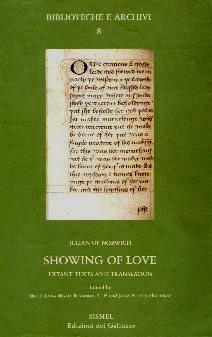 To see an example of a page inside with parallel text in Middle English and Modern English, variants and explanatory notes, click here. Index to this book at http://www.umilta.net/julsismelindex.html
To see an example of a page inside with parallel text in Middle English and Modern English, variants and explanatory notes, click here. Index to this book at http://www.umilta.net/julsismelindex.html
Julian of Norwich. Showing of Love: Extant Texts and Translation. Edited. Sister Anna Maria Reynolds, C.P. and Julia Bolton Holloway. Florence: SISMEL Edizioni del Galluzzo (Click on British flag, enter 'Julian of Norwich' in search box), 2001. Biblioteche e Archivi 8. XIV + 848 pp. ISBN 88-8450-095-8.
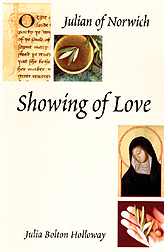 To see inside this book, where God's words are in red, Julian's in black, her editor's in grey, click here.
To see inside this book, where God's words are in red, Julian's in black, her editor's in grey, click here.
Julian of Norwich. Showing of Love. Translated, Julia Bolton Holloway. Collegeville: Liturgical Press; London; Darton, Longman and Todd, 2003. Amazon ISBN 0-8146-5169-0/ ISBN 023252503X. xxxiv + 133 pp. Index.
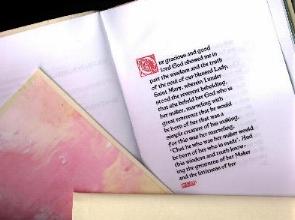 To view sample copies, actual size, click here.Julian of Norwich, Showing of Love, Westminster Text, translated into Modern English, set in William Morris typefont, hand bound with marbled paper end papers within vellum or marbled paper covers, in limited, signed edition. A similar version available in Italian translation. To order, click here.
To view sample copies, actual size, click here.Julian of Norwich, Showing of Love, Westminster Text, translated into Modern English, set in William Morris typefont, hand bound with marbled paper end papers within vellum or marbled paper covers, in limited, signed edition. A similar version available in Italian translation. To order, click here.
 'Colections' by an English Nun in Exile: Biblioth�que Mazarine 1202. Ed. Julia Bolton Holloway, Hermit of the Holy Family. Analecta Cartusiana 119:26. Eds. James Hogg, Alain Girard, Daniel Le Bl�vec. Salzburg: Institut f�r Anglistik und Amerikanistik Universit�t Salzburg, 2006.
'Colections' by an English Nun in Exile: Biblioth�que Mazarine 1202. Ed. Julia Bolton Holloway, Hermit of the Holy Family. Analecta Cartusiana 119:26. Eds. James Hogg, Alain Girard, Daniel Le Bl�vec. Salzburg: Institut f�r Anglistik und Amerikanistik Universit�t Salzburg, 2006.
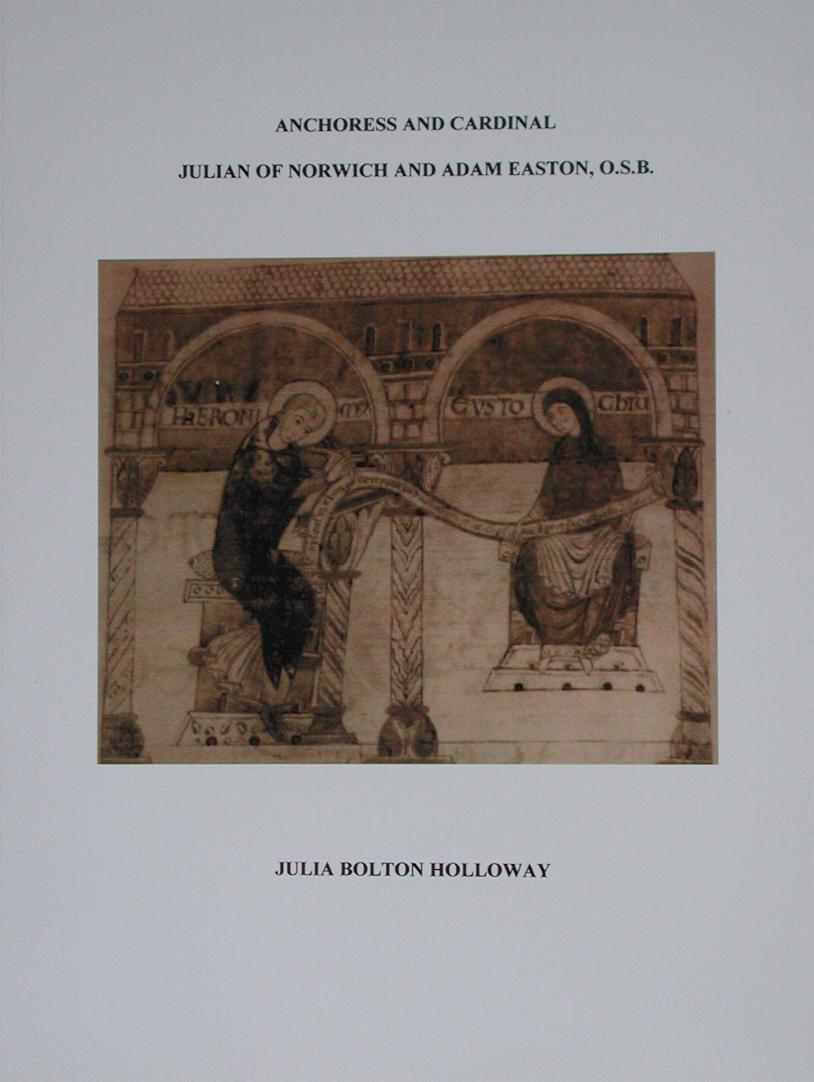
Anchoress and Cardinal: Julian of Norwich and Adam Easton OSB. Analecta Cartusiana 35:20 Spiritualit�t Heute und Gestern. Salzburg: Institut f�r Anglistik und Amerikanistik Universit�t Salzburg, 2008. ISBN 978-3-902649-01-0. ix + 399 pp. Index. Plates.
Teresa Morris. Julian of Norwich: A Comprehensive Bibliography and Handbook. Preface, Julia Bolton Holloway. Lewiston: Edwin Mellen Press, 2010. x + 310 pp. ISBN-13: 978-0-7734-3678-7; ISBN-10: 0-7734-3678-2. Maps. Index.

Fr Brendan Pelphrey. Lo, How I Love Three: Divine Love in Julian of Norwich. Ed. Julia Bolton Holloway. Amazon, 2013. ISBN 978-1470198299
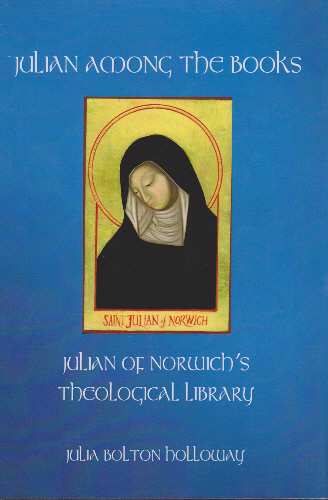
Julian among the Books: Julian of Norwich's Theological Library. Newcastle upon Tyne: Cambridge Scholars Publishing, 2016. xxi + 328 pp. VII Plates, 59 Figures. ISBN (10): 1-4438-8894-X, ISBN (13) 978-1-4438-8894-3.

Mary's Dowry; An Anthology of Pilgrim and Contemplative Writings/ La Dote di Maria:Antologie di Testi di Pellegrine e Contemplativi.Traduzione di Gabriella Del Lungo Camiciotto. Testo a fronte, inglese/italiano. Analecta Cartusiana 35:21 Spiritualit�t Heute und Gestern. Salzburg: Institut f�r Anglistik und Amerikanistik Universit�t Salzburg, 2017. ISBN 978-3-903185-07-4. ix + 484 pp.
For Mediatheca 'Fioretta Mazzei' library holdings on Julian of Norwich and other contemplatives, from which these books were written, see http://www.florin.ms/libgimel.html. The library is housed in the 'English' Cemetery, P.le Donatello, 38, 50132 FIRENZE, ITALY and one may become a member and reader through the gift to it of a book a year. Scholars have come to it from Australia, America, New Zealand, Russia, Belgium, France, Norway, Sweden, Ireland, England.
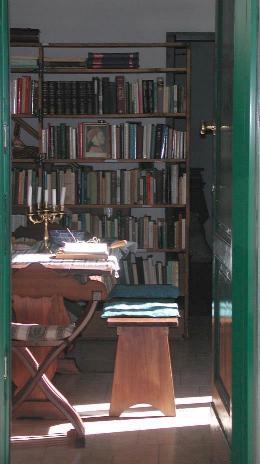

{ External Links�
Edmund Gardner, 'Julian of Norwich, Catholic Encyclopedia� || Julian of Norwich. Showings. Trans. Grace Warrack, 1901� General/Contemplative || Julian of Norwich. Showings. Ed. Georgia Ronan Crampton� Middle English. Scholar || Jacques de Vitry on Marie d'Oignies� Latin. Scholar || Frater A on Angela of Foligno, Memorial, and Instructions� Latin. Scholar || ORB Encyclopedia Website, Monastic Orders� General, Scholar || Iter: Medieval Manuscript Catalogue� Scholar || Libraries with Manuscripts� Links Scholar ||Luminarium Medieval Studies Website� Student || To Visit St Julian's Church in Norwich, Browse Further Amongst Norwich's Streets|| And Enter The Julian Shrine, Norwich, England� || Order of Julian of Norwich Website� Contemplative American Anglican Order || The Julian Meetings Contemplative Prayer Groups � || The Life and Writings of Gerontissa Gabrielia Contemplative Excellent || Russian Icon School� || Coptic Spirituality: Anasimon, Queen of Anchoresses� || Carmina Gadelica, Celtic Prayers in Gaelic and English� Contemplative. Excellent || The Dove's Kinswoman On Anointing, Women, Early Christianity || The Baltimore Carmel� Gateway to Carmelite Texts. Contemplative || Modern Anchoress� Quaker Links. Contemplative || Peace Pilgrim� Contemplative
JULIAN OF NORWICH, HER SHOWING OF LOVE AND ITS CONTEXTS �1997-2024 JULIA BOLTON HOLLOWAY || JULIAN OF NORWICH || SHOWING OF LOVE || HER TEXTS ||HER SELF || ABOUT HER TEXTS || BEFORE JULIAN || HER CONTEMPORARIES || AFTER JULIAN || JULIAN IN OUR TIME || ST BIRGITTA OF SWEDEN || BIBLE AND WOMEN || EQUALLY IN GOD'S IMAGE || MIRROR OF SAINTS || BENEDICTINISM || THE CLOISTER || ITS SCRIPTORIUM || AMHERST MANUSCRIPT || PRAYER || CATALOGUE AND PORTFOLIO (HANDCRAFTS, BOOKS ) || BOOK REVIEWS || BIBLIOGRAPHY ||
